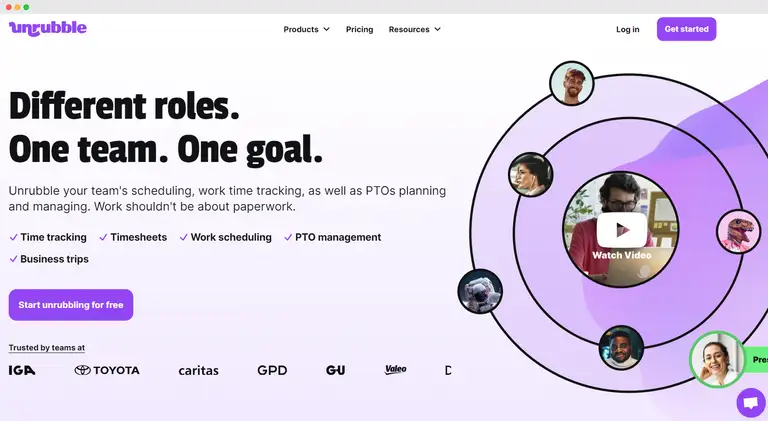Is your business falling behind? Are employees suddenly losing motivation? Is your revenue starting to dip?
Sometimes, workforce challenges can hit harder and faster than we'd like.
To stay ahead, you need to optimize how your business operates.
So today, we're sharing seven powerful strategies that can turn these setbacks into growth opportunities for your business:
What is workforce optimization?
In simple terms, it's making sure the right people are doing the right tasks at the right time. A workforce optimization strategy involves automating processes to cut down on wasted time and get the most out of every team member.
Thanks to focusing on things like scheduling, performance, and productivity, workforce optimization helps businesses run properly and keeps the whole team on track. It’s not just about working harder but, most importantly, working smarter to get the best results with the resources you’ve got.

7 workforce optimization techniques that really work
Check out these 7 workforce optimization strategies now:
Data-driven scheduling
Use data to plan work shifts that match demand. This technique keeps operational costs down and strengthens employee productivity. All because you have the right number of people at the right time.
Expert tip: Use historical data to spot trends in your business's busiest times. For example, if you run a retail store, track which days and hours see the highest foot traffic. Then, schedule more team members during those peak hours. Regularly review and update this data to keep up with seasonal or unexpected changes.
Check this out: how to create a schedule?
Automate repetitive tasks
Automating processes like shift planning or reporting frees up time for your team to focus on more valuable tasks. It also reduces errors, which helps with overall operational efficiency.
Expert tip: Start by automating the most repetitive tasks, like payroll and shift scheduling. Use automation tools to handle these processes with minimal supervision, freeing up more time for your team to focus on strategic activities that drive business growth.
Time tracking and scheduling tools
Using time tracking and scheduling tools gives you a clear picture of how your team spends their hours. It helps you spot inefficiencies, adjust schedules on the go, and maximize workforce performance.
Expert tip: With Unrubble, you can set up real-time alerts for when employees clock in late or work overtime. This way, you can quickly address any issues before they become bigger problems.
Plus, you get the option to encourage your team to use Unrubble's Employee Self-Service App so they can easily manage their schedules, request time off, and track their hours. Try it for free today.

P.S. That's not all we do! With our solution, you'll also handle:
Learn more by going to our website now.
Performance management systems
Track how well your team members are doing with clear performance metrics. This is awesome for identifying top performers and those who might need a little more support, leading to better workforce management.
Expert tip: Set specific, measurable goals for each team member that tie directly to business outcomes. Use monthly check-ins to discuss progress and adjust targets if needed. This keeps everyone aligned with the company's goals while identifying areas for improvement.
Check this out: performance review examples, Performance Improvement Plan (PIP) explained
Employee engagement initiatives
A team that feels connected to their work tends to be more productive. Simple engagement tactics, like regular check-ins or recognizing achievements, can go a long way in strengthening morale.
Expert tip: Regularly gather feedback from your team through anonymous surveys to understand what motivates them and where they might be facing challenges. Act on this feedback to make small changes that have a big impact on morale and engagement.
Check this out: 5 reasons why employee engagement really matters
Integrated workforce optimization software
Using software that integrates business performance considerations into its design makes it easier to manage tasks and track goals.
Expert tip: Choose software that fits with your existing tools. Look for features like data integration and analytics, which help tie daily operations directly to your business goals. Regularly review the data to take steps that drive long-term growth and operational efficiency.
Cross-training employees
Train your team members to handle different roles. This not only makes your workforce more flexible but also helps solve business problems related to unexpected absences or peak times.
Expert tip: Identify key skills within your team that can be developed and matched with different roles. Schedule regular cross-training sessions where employees learn new skills that prepare them to step into other positions when needed, adding flexibility to your workforce.
Check this out: pros and cons of upskilling employees
Who needs workforce optimization strategies? 5 examples
Below you will find 5 examples of who needs workforce optimization:
Small business owners
Expansion is one of the top priorities for small businesses. However, for many (38%), finances are a big obstacle.
That’s where a workforce optimization strategy comes in handy. It helps you cut costs and keep your team productive without burning everyone out.
Using the right tools, you can get a clear view of how your business is performing so your crew stays motivated and efficient.
Check this out: small business scheduling tips
Human Resources teams
The Society for Human Resource Management (SHRM) states that an HR manager typically has to take care of around 25 employees at the same time.
A solid workforce optimization strategy can do wonders by automating repetitive tasks and letting them focus on other duties.
When everything aligns, your employees get more done, customers are happier, and the whole company benefits from better quality management.
Check this out: the ultimate guide to HR planning
Call centers

Call centers live and breathe efficiency. The recommended occupancy rate (time when agents are actively handling calls or engaging in productive work) is between 85% and 90%.
To hit their targets, they need agents ready to jump on calls and deliver great customer service.
Workforce optimization strategies make sure they’ve got the right number of people on hand.
Retail chains
Retail businesses know how tricky it can be to match staffing with customer flow. Getting it wrong can mean long lines or empty aisles.
However, a good workforce optimization plan can help predict busy times and put people in the right places.
It’s all about making the shop run like a well-oiled machine, keeping both the staff and customers in a good mood.
Manufacturing companies

In manufacturing, every minute counts. Downtime or delays can mess up the whole process. The International Society of Automation reports that unplanned downtime causes the average manufacturing plant to lose between 5% and 20% of its yearly productivity.
That’s why workforce optimization is a game changer.
It tracks who’s doing what, fixes the bottlenecks, and lines up the team’s efforts with the bigger business goals.
To be clear, these are just a few examples. The truth is that almost any business, big or small, might need a workforce optimization strategy sooner or later. You just need to find the right approach to keep operations running and make the most out of your team's potential.
When is workforce optimization needed?
It’s usually when something's off balance.
It could be any of these:
When customer satisfaction drops,...
...it’s time to rethink how your team works. A little shift toward employee productivity and operational efficiency can turn things around. When your workforce optimization software integrates business performance considerations into daily tasks, everyone gets back on track.
When your employees seem unmotivated,...
...you should focus on employee engagement. Sometimes, tweaking your performance management can make a big difference in workforce performance. If your goal is a successful workforce optimization, finding a business strategy that matches your needs is a must.
Check this out: 8 ways to increase motivation in the workplace, how to overcome procrastination in the workplace
When you're stuck solving business problems related to team output or project delays,...
...a closer look at how everyone’s working can help. That’s where workforce optimization steps in, helping you tweak what’s needed to get the most out of your team.
When your business strategy isn’t hitting the mark,...
...it might be good to consider how your team’s tasks align with your goals. Focusing on workforce management can help steer things back in the right direction.
Conclusion
From data-driven scheduling to employee engagement initiatives, these seven strategies we've just shown you will help you fine-tune your team's productivity and drive real results.
But why stop there? Unrubble's tools can take your workforce optimization to the next level and make it easier to manage time tracking, scheduling, PTO, and more.
Try Unrubble today and see how a well-optimized team can transform your business.



![What Does PEO Stand For In HR Administration? [2026 Guide]](/static/image?src=https%3A%2F%2Fcdnblog.unrubble.com%2Fpayload-unrubble-images%2FUnrubble-what-does-peo-stand-for-in-hr-administration-180x120.jpg&width=128&height=128&fit=cover&position=center&quality=65&compressionLevel=9&loop=0&delay=100&crop=null&contentType=image%2Fwebp)



